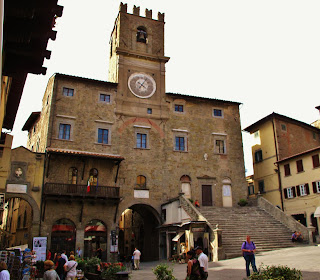Cortona is perched upon a 1700 foot hill overlooking a fertile valley, with sweeping views of Lake Trasimeno and the Umbrian countryside. Cortona has become a pilgrim site for those seeking the Tuscan Sun...

It's been over twenty years since Frances Mayes captured our hearts and imagination (not to mention our stomachs!) with her story of renovating an old villa named Bramasole in the hilltown of Cortona. The 1997 movie loosely based on Mayes' book Under The Tuscan Sun became a bestseller and one of my favourites, and I knew I needed to make a pilgrimage to this classic village in Southern Tuscany. But what is it about this rustic Tuscan hilltown that beckons people to fantasize about leaving their life behind and moving to Italy? Cortona emits a laidback, friendly, community vibe and I would encourage you to explore the town for at least an overnight instead of pulling up in front of Bramasolle to take the "I was here" photo.

Cortona is also central to Rome (2.5 hrs) Florence (1.5 hrs) Assisi (1 hr). If you are taking the train to Cortona there are two stations located at the valley floor in the town of Camucia or one about 10 minutes South in Terontola, depending on where you are coming from. Both train stations have busses that run up the hill to Cortona's main Piazza Garibaldi hourly. Cars are a bit more difficult to navigate through the narrow and steep streets, but there are several free parking lots outside the city walls including Santo Spirito Church and the Santa Margherita Basilica at the top of the hill.

Margherita of Cortona had an interesting and tragic life. She was born on a nearby farm in 1247 and at 17 ran off with the son of a rich Lord to live as his wealthy mistress in a castle in Montepulciano. When her lover was murdered, Margherita and her son gave up her life of luxury and became homeless ending up in Cortona and taken in by the monks of Saint Francis. She followed the order of Franciscans taking a vow of poverty and her nickname became "La Poverella" or "little poor one." Margherita established a hospital in Cortona and an order of sister-nurses called le poverelle.

The basilica interior is painted in blues and gold with a ceiling full of metallic gold stars, like the night sky. A carved wooden crucifix from the 1200s is at the alter and is the same crucifix Margherita prayed to at her time in Cortona. To check hours of the basilica visit www.santamargheritadacortona.com
 |
| Girifalco Fortress |
Above Santa Margherita is an impressive fortress. The well preserved Girifalco Fortress was built during Santa Margherita's time in 1258 but was rebuilt to its current appearance in 1500 on the order of Florence's Cosimo De Medici. The castle foundations date back to the Etruscan era, and extensive renovations completed in 2010 sees the fortress as an art Gallery, culture center and a bistro.
You can climb the ramparts and for stunning views of the Val di Chiana, lake Trasimeno and Umbria about a mile beyond. The entrance to Girifalco Fortress is €5. For times and events check www.fortezzadelgirifalco.it
Cortona was one of the largest Umbrian settlements until it
was captured by the Etruscan, who named
it Curtun, which means "enclosed place" probably because there was a wall that surrounded the settlement.
Parts of this 2,500-year-old city wall and its gate can be seen today at
Porta Bifora on the Westside entrance to Cortona.
 |
| View From The Fortezza |
The Cortona Etruscan Archeological Museum is a great place to learn about the mysterious indigenous people of Tuscany. The museum is housed in a 13th-century De Medici palace called Pallazo Casali on Piazza Signorelli. In this quiet museum, you will find Etruscan artifacts galore, including the Cortona Tablet, a second century BC, 200-word bronze tablet discovered in 1992 that has helped archaeologists learn more about the Etruscan civilization. There is also an exhibit on the Roman colonization of "Curtun," which the Romans changed to Corito.
Tickets to the MAEC are €10, and a combo ticket to include the Archeological Park is €13. Visit the MAEC website for more information: www.cortonamaec.org/it/
Another of Cortona's noteworthy museums is the nearby Diocesan Museum. Located in the former Church of Gesú on Piazza del Duomo. The Diocesan Museum houses stunning works by pre and early Renaissance heavyweights like Fra' Angelico, Pietro Lorenzetti, Sassetta. There is a whole room dedicated to Cortona's own Renaissance master, Luca Signorelli, whose memory lives on in the hilltown today. The cost of the Diocesan Museum is €6, which comes with a free audioguide. For times and more info, click the link to Cortona Diocesan Museum.

Cortona is a DOC wine region with excellent red, white and Vin Santo (dessert wine) offerings. Cortona boasts about 20 wine bars called Enoteca's offering the region's best wines by the glass or bottle. The Cortona Syrah is one of the most notable and delicious wines produced in the area. There are winery tours available; check at the Tourist Centre located in the courtyard of the Etruscan Museum for more information. There is also a craft microbrewery and gastropub called Birrifico Cortonoese, providing delicious snacks with three on tap beers-or take a bottle home as a souvenir. There is no shortage of excellent restaurants in Cortona, serving fresh, local traditional food.





